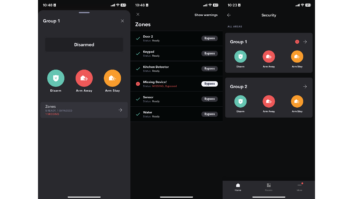In the 1982 classic horror film Poltergeist, the medium Tangina Barrons cajoles the confused and unsettled spirits to find solace, saying, “Crossover children. All are welcome. All welcome. Go into the light. There is peace and serenity in the light.” In much the same way, the integration industry should be doing the same.

ThinkStock
The Gigabit home is the future come to fruition. The modern networked home with its interconnectivity and ability to deliver content and control to any room, has allowed the World of Tomorrow dreams to become the everyday.
The homes that we install, manage, and maintain with multiple streams of AV, control, and monitoring are slowly, but steadily becoming — if not quite ubiquitous, more common. We, as an industry, are finally becoming comfortable (well mostly) with the technology and tools to implement these networks. Many of us now find it second nature to use them. Yet there is a problem.
The industry has made great strides in getting educated, certified, and competent in the best practices of installing category cable networks. But, truth be told, it is already a process of the past.
With the ability to provide on-demand, high-bandwidth quality distributed content, comes the demand for more. Delivering 4K 4:4:4 60 UHD video with surround has become the standard to achieve, and we revel in the bliss of it all. But 8K is calling, chattering IoT devices are beginning to fill in spaces everywhere, and management systems are taking on more roles.
The network needs of the near future will require a backbone beyond 10g speeds, and it will need the ability to scale up with a minimum of data compression or compromises. What we need is a serious and committed move to fiber.
Copper has served us well. The technical and social revolutions that gave rise to Silicon Valley and an extraordinary wave of venture capital start ups (and the single most valuable company in the world) all rode on the wave Category cable.
The method and techniques of copper for data is so common that it is taught in middle school classes. The parts and tools can be easily obtained from electronics box stores, local hardware stores, wholesale outlets, and home improvement chains.
All of this availability has made Category copper cable extraordinarily inexpensive that it borders on being “cheap.” Heck, every local electrician includes running a couple of lines of Cat-5 along with RG6 as part of their fee, often takeing away a profit center from us. We have all seen the “sparkies” who do a passable job and those who completely muck it up. But, the general contractors see no difference; it is “just cable,” after all.
The cable is also very tolerant to the abuses and misuses incurred when running the cables. We pull them beyond the tension limits, run them past nests of BX and, bend them to just beyond acceptable radius. Still this backbone often works, sometimes for years, with no indication of problems.
Copper works best when installed in short dedicated runs. On the surface, this looks to be a perfect fit for the type of installations that we are involved in. Consider, though, that copper cable has a 90-percent signal degradation over 100 meters. This is not an insubstantial loss. As we work to use more bandwidth and higher frequencies modulated across the strands, our potential distance reduces even further.
To combat these built-in deficiencies, cables have been improved with physical separators (enlarging and stiffening the cable) increasing the twists per centimeter and bonding the pairs. Shielding and specialized jackets have been developed to resist the influence of spurious electrical noise and EMF. Unfortunately, the limits of physics have come into play here; there are only so many twists that can be done before we run out of space between atoms.
Don’t Fear the Fiber
When integrators speak of fiber, we often think of two things: the large municipal feeds — like those installed in urban financial centers — or Google fiber and the copper-to-adapter boxes.
Most often, the AV world sees fiber in the light of the fantastical, white overcoat-wearing MIT researchers building supercomputers or battle robots. There is some truth to the “rarified air” of fiber; it is a different technology, using light rather than electrical signals. The technology also requires a retooling of both individual knowledge and equipment.
Many still hold the impression that the running and termination of fiber requires “clean rooms,” lab coats, and high tech headsets. It is true that early fiber required a considerable amount of preparation, dangerous epoxies, breathing masks, and microscopes. Since the early 2000s, however, a number of manufacturers have offered quick-termination kits that simplify the process to a few steps. Splicing fiber is a bit more work, but there are great kits that, once set up, accommodate connecting fiber runs in less than five minutes. Often these splices can be accomplished with nearly zero loss of signal. Try that with copper. Termination and verification does take a few more moments to accomplish and requires the work to be done after things like spackle sanding have been completed.
As would be expected, fiber is more expensive than copper by a considerable amount. How can running it be justified in tight markets and diminishing margins? Fiber is the answer to our current and future bandwidth needs — straight and simple, it beats our copper and the highest tech wireless mediums by far.
Earlier, it was noted that copper can lose up to 90 percent of signal strength over just 100 meters of cable and that the fix is to add more equipment between source and destination. Fiber, especially single mode, will lose only three percent of its original signal strength over the same distance. Multimode will lose just a bit more due to the fact that it carries a number of wavelengths and bounces them down the cable.
Fiber can also run adjacent to electrical lines, as it is unaffected by EMF, EMI, or grounding issues. The light beam gets to its destination regardless of who came in after your pulls and can even be “buried” in BX with no loss of signal integrity. When running multiple lines of copper, not only do we need to keep a distance from electrical runs, but in many cases we need to insure a minimum distance between our AV lines. With fiber, this is also unnecessary.
When running copper data cable, it is standard practice to run “spares” for upgrades or to be terminated if the primary line goes down. Fiber cables for home installation come bundled with multiple lines, and these lines are often overkill for the application and therefore provide “dark lines” ready for upgrade/expansion use later.
In AV, we have a need for speed. Our clients’ expectations demand top performance, and fiber fits the bill with speeds of 1TB/sec for single runs and potential 100 TB/sec with optimized modes.
Cost Considerations
As mentioned, copper is cheap to buy and run but has inherent limitations that stymie our ability to deliver truly high-speed infrastructure to our clients.
Fiber, with its higher speed capacity, increasing ease of installation, resistance to loss over distance, imperviousness to common electrical interference and inherent capacity for expansion makes for good business sense. The initial cost of implementing may be higher, but over the long run, the benefits can actually lower your costs to meet the installations’ future needs.
It is also a technology that we as an industry can take ownership of, leaving the electricians to run their power and leave our networks alone.







